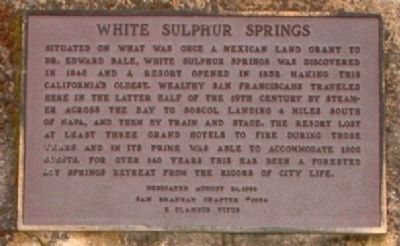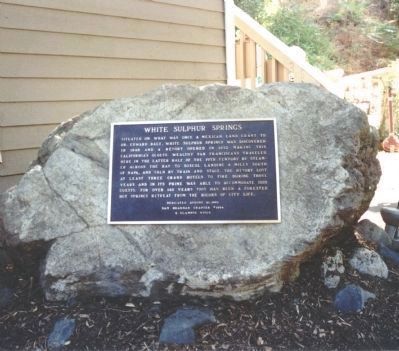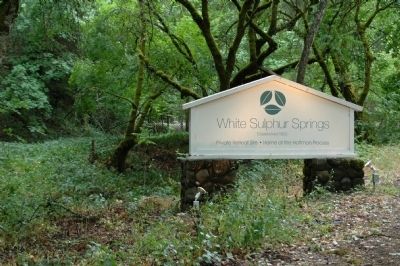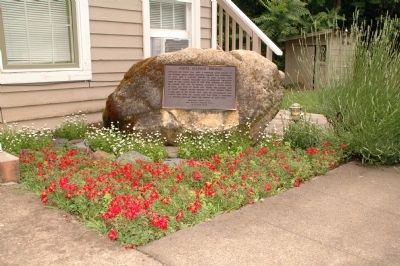Near St. Helena in Napa County, California — The American West (Pacific Coastal)
White Sulphur Springs
Erected 1993 by Sam Brannan Chapter #1004 E Clampus Vitus.
Topics and series. This historical marker is listed in these topic lists: Entertainment • Industry & Commerce. In addition, it is included in the E Clampus Vitus series list. A significant historical year for this entry is 1848.
Location. 38° 29.441′ N, 122° 29.926′ W. Marker is near St. Helena, California, in Napa County. Marker is on White Sulphur Springs Road, on the right when traveling west. Plaque is mounted on a large stone in front of the office of White Sulphur Springs. Touch for map. Marker is at or near this postal address: 3100 White Sulpher Springs Road, Saint Helena CA 94574, United States of America. Touch for directions.
Other nearby markers. At least 8 other markers are within 2 miles of this marker, measured as the crow flies. Sophie Alstrom Mitchell (about 500 feet away, measured in a direct line); Beringer Brothers Winery (approx. 1.7 miles away); Hudson House (approx. 1.7 miles away); NSGW & Historic District (approx. 1.8 miles away); Richie Block (approx. 1.9 miles away); Charles Krug 1825 - 1892 (approx. 1.9 miles away); Charles Krug Winery (approx. 1.9 miles away); Cesare Mondavi 1883 – 1959 (approx. 1.9 miles away). Touch for a list and map of all markers in St. Helena.
Additional commentary.
1. Additional Information Regarding the Marker Dedication
Tony Torell was Noble Grand Humbug when this plaque was dedicated. Plaque wording by Loren A. wilson.
— Submitted April 18, 2012, by Loren Wilson of Sebastopol, California.
2. White Sulphur Springs.- Dedication 21 August 1993
In a little wrinkle of a valley just west of the Napa Valley town of St. Helena, oaks lean intimately from the close sides of the valley and a copse of redwoods stands peacefully next to a serene occasional creek. The hillsides are here and there patched with poison oak and hiking trails wind their way up the little valley. At the wide, eastern end of the valley a complex of refurbished buildings marks the White Sulphur Springs Resort, the oldest operating resort in Alta California, dating to 1852.
The fame of the resort comes from its natural sulfur springs, six producing cold water, and a seventh depositing warm sulfur-rich water into a bathing pool that has been used for centuries for its curative powers. The resort in the remote little valley appears to be incredibly peaceful, but in reality, it has experienced a rollercoaster history of fame and flame, one year a prosperous resort, the next a ruin. It seems almost to be the site of warring spirits.
Indian arrowheads are still occasionally found on the grounds, but it is difficult to determine just how the local Indians regarded the sulfur springs. There are several Indian legends that view the springs as a source of holy waters valued for their curative powers. Evidence of Indian occupation of the area goes back some 2000 years. But on the flip side of the archeologist's spade, some historians contend that if, indeed, the springs were regarded as holy, there would have been much more evidence of Indian occupation than has been found. They contend that many Indians likely regarded the noxious fumes rising from the springs to be a sign that the water was inhabited by demons.
Throughout its history, white men fared no better at White Sulphur Springs than the Indians: enthralled and rewarded on one hand, enthralled and devastated on the next.
Napa Valley in the first decades of the 19th century was peaceful and virtually ignored by explorers. The Russians pushing in from the north established Ft. Ross along what is now the Sonoma Coast, while the Mexicans pushed up from the south, and in order to counter the Russians, built the last--and most northerly--of their missions at Sonoma. Napa (then spelled Nappa) Valley was ignored. But in 1837, a 29-year-old surgeon, Dr. Edward Turner Bale landed at Monterey, where he fell under the charms of Maria Ignacia Seberanes, a niece of General Vallejo. In 1839, Bale was given a land grant called Came Humana Rancho, which included what is now St. Helena and White Sulphur Springs.
Two men who purchased land in the St. Helena area from Dr. Bale are credited with discovering the springs. John York and his brother-in-law David Hudson came upon them in 1848, probably while hunting, and told Dr. Bale of their existence.
The springs themselves, however, were purchased by Dr. Lilley, a physician from Kentucky and a friend of Dr. Bale's. But when Dr. Lilley went to claim his springs, he found a collection of Mexicans and Wappo Indians squatting on the property and he was required to repurchase it from them--for the price of one musket and two mules. Dr. Lilley built the first crude bath house at the springs and brought people in to take "the cure" from the waters for a variety of ills, including arthritis and rheumatism.
The land was purchased by Taft and Brewster, an investment brokerage firm in San Francisco, in 1850; it was developed as a private retreat in 1851 and opened to the public in 1852. The retreat featured cottages, a dining room, and a bowling alley made of 3x12" planks set on edge. The resort prospered so prodigiously that in 1859 a group put together a stock offering of $100,000 to build a luxury hote250' long. Unfortunately, a short time later the grand hotel was destroyed by fire. (That's Hotel Fire #1.)
Swen Alstrom, who had an operating interest in both the Oriental (corner of Bush and Battery streets) and the Lick hotels in San Francisco, heard that Taft & Brewster wanted to unload the White Sulphur Springs property. Mr. and Mrs. Alstrom visited the site in July of 1861, Swen fell in love with it, and made arrangements to buy the property. Over that winter, a devastating storm pretty much wiped out what remained of the resort, including the bowling alley, allowing Alstrom to begin from scratch.
Swen and his wife moved to the springs in March 1862 and he commuted between that site and his holdings in San Francisco until he disposed of his city holdings in 1868.
Wealthy San Francisco businessmen, led by Dan Koshland, chairman of Levi Straus & Co., were so fond of visiting the Springs and taking their work with them, that they banded together to underwrite the cost of installing a direct telegraph line from the SF Stock Exchange to the springs so they could stay current on their business interests.
Capt. Alstrom spent a fortune turning the Springs into a showplace, and the culmination of his dream was to be the construction of the two-story Oriental Hotel, an opulent luxury accommodation much like its predecessor. It was completed in 1875 and soon after burned to the ground when a drunken employee threw a Fourth of July firecracker onto the roof, where it smoldered in a clump of dead leaves until it ignited in the middle of the night. (That was Hotel Fire #2.)
The property changed hands several times and invariably a hotel was again added. After the Oriental Hotel fire in 1875, the Van Dewater Cottage Hotel with 30 rooms was built. In 1882 Jerome Lincoln purchased the property and built a second hotel that accommodated 250 guests. In 1892 the Security Savings Bank of San Francisco took the property over and attempted to run it from afar but it was not successful. In 1904 John Sanford bought the Springs. Sanford added to the hotel mania, with the resort reaching a capacity of 1000 guests. Unfortunately, in 1905 the main hotel burned (Hotel Fire #3) but Sanford immediately rebuilt on the same spot.
When Sanford died in 1915, the property was purchased by W. F. Mercier of St. Helena, who built the swimming tank that is still in use today. A bath-house was added in 1921. In 1933 William Henry Harrison Davis purchased the resort from Mercier but kept the former owner on as manager. In 1938 the dance pavilion was converted to a hotel and major improvements were made throughout.
In 1941 the Springs were purchased by Frank Lucas, who then sold it to Charles Mowers in 1944, who sold it to a Mr. Rude (a San Francisco lithographer) in 1946 who in turn sold it to John M. Gordon (a Laguna Beach resort businessmen) the following year.
But the very next year, 1948, it was purchased by Bob Campbell of Sausalito, who turned it into Bob's Steak House, complete with bar, dancing, sulphur baths, and hotel accommodations. In 1951 the resort was purchased by William Nickerson, a former telephone company executive, who renamed it Sun Valley. In 1955 the property was purchased by Max Friedman, who operated it for two years as an exclusive boys' camp.
In 1957 the Methodist Church Conference purchased the property and held it as a private camp until 1974, when it was sold to Hadassah, the Northern California Zionist Youth Commission, as an educational training center, camp, and year-round retreat. In 1977 it was purchased by Sanatana Dharma Foundation as a religious and educational retreat, during which period the buildings fell into a state of disrepair.
In 1983 Seward "Buzz" and Betty Foote purchased White Sulphur Springs both as a family home and as community affordable housing. In 1989, Napa County determined its historic use and, therefore, its present use to be that of a public resort. And so the Footes shortly thereafter began to extensively refurbish it as such.
At present, it offers overnight accommodations and also caters to longer group retreats in the two quaint inns and eight rustic cottages. There are meeting rooms, a redwood grove for wedding ceremonies, hiking trails to waterfalls, an outdoor group-sized Jacuzzi, and the intimate warm sulfur soaking pool. And there is more to come with the restoration of the old bath house into a modern affordable spa. All in all, it is a delightful getaway type of place that immediately charms all who wander into its embrace.
Rich Benyo—1993
— Submitted April 18, 2012, by Loren Wilson of Sebastopol, California.
3. Who owns White Sulphur Springs now
As of 2000, White Sulphur Springs resort was purchased by the Hoffman Institute and is no longer a resort and spa.
— Submitted April 22, 2015.
Credits. This page was last revised on June 16, 2016. It was originally submitted on April 18, 2012, by Loren Wilson of Sebastopol, California. This page has been viewed 1,799 times since then and 119 times this year. Last updated on April 22, 2015, by Liz Peddy of Angwin, Californa. Photos: 1, 2, 3, 4. submitted on April 18, 2012, by Loren Wilson of Sebastopol, California. • Bill Pfingsten was the editor who published this page.



